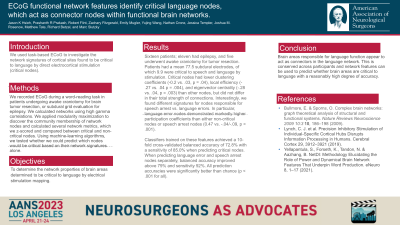Network features identify critical language nodes, which act as connector nodes within functional brain networks.
Network Features Identify Critical Language Nodes, Which Act as Connector Nodes Within Functional Brain Networks
Friday, April 21, 2023


Jason K. Hsieh, MD, MS
Resident
Cleveland Clinic Foundation
Cleveland, Ohio, United States
ePoster Presenter(s)
Introduction: We used task-based ECoG to investigate the network signatures of cortical sites found to be critical to language by direct electrocortical stimulation (critical nodes).
Methods: We recorded ECoG during a word-reading task in patients undergoing awake craniotomy for brain tumor resection, or subdural grid evaluation for epilepsy. We calculated networks using high gamma correlations. We applied modularity maximization to discover the community membership of network nodes and calculated several network metrics, which we z-scored and compared between critical and non-critical nodes. Using machine-learning algorithms, we tested whether we could predict which nodes would be critical based on their network signatures alone.
Results: Results
We included sixteen patients; eleven had epilepsy, and five underwent awake craniotomy for tumor resection. Patients had a mean 77.5 subdural electrodes, of which 9.9 were critical to speech and language by stimulation. Critical nodes had lower clustering coefficients (-0.2 vs. .03, p = .04), local efficiency (-.27 vs. .04 p = .004), and eigenvector centrality (-.28 vs. .04, p = .003) than other nodes, but did not differ in their total strength of connections. Interestingly, we found different signatures for nodes responsible for speech arrest vs. language errors. In particular, language error nodes demonstrated markedly higher participation coefficients than either non-critical nodes or speech arrest nodes (0.47 vs. -.04/-.09, p < .001).
Classifiers trained on these features achieved a 10-fold cross-validated balanced accuracy of 72.8% with a sensitivity of 85.0% when predicting critical nodes. When predicting language error and speech arrest nodes separately, balanced accuracy improved above 79% and sensitivity 92%. All prediction accuracies were significantly better than chance (p < .001 for all).
Conclusion : The network signatures of cortical areas causing language errors when stimulated suggest they act as connectors between communities in the language network. Network features alone may identify critical language sites.
Methods: We recorded ECoG during a word-reading task in patients undergoing awake craniotomy for brain tumor resection, or subdural grid evaluation for epilepsy. We calculated networks using high gamma correlations. We applied modularity maximization to discover the community membership of network nodes and calculated several network metrics, which we z-scored and compared between critical and non-critical nodes. Using machine-learning algorithms, we tested whether we could predict which nodes would be critical based on their network signatures alone.
Results: Results
We included sixteen patients; eleven had epilepsy, and five underwent awake craniotomy for tumor resection. Patients had a mean 77.5 subdural electrodes, of which 9.9 were critical to speech and language by stimulation. Critical nodes had lower clustering coefficients (-0.2 vs. .03, p = .04), local efficiency (-.27 vs. .04 p = .004), and eigenvector centrality (-.28 vs. .04, p = .003) than other nodes, but did not differ in their total strength of connections. Interestingly, we found different signatures for nodes responsible for speech arrest vs. language errors. In particular, language error nodes demonstrated markedly higher participation coefficients than either non-critical nodes or speech arrest nodes (0.47 vs. -.04/-.09, p < .001).
Classifiers trained on these features achieved a 10-fold cross-validated balanced accuracy of 72.8% with a sensitivity of 85.0% when predicting critical nodes. When predicting language error and speech arrest nodes separately, balanced accuracy improved above 79% and sensitivity 92%. All prediction accuracies were significantly better than chance (p < .001 for all).
Conclusion : The network signatures of cortical areas causing language errors when stimulated suggest they act as connectors between communities in the language network. Network features alone may identify critical language sites.
